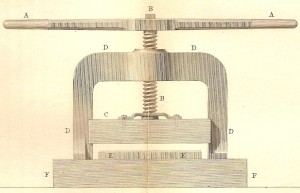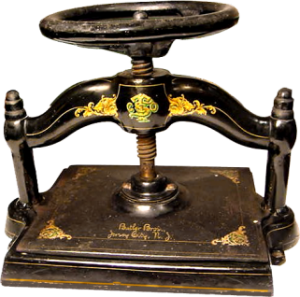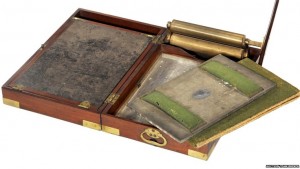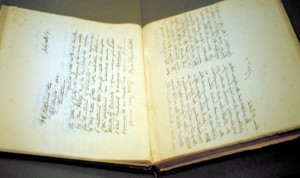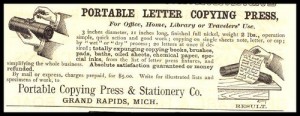Patent diagram for James Watts copying press, 1780
In 1780 the Scots inventor James Watt (also the inventor of the steam engine) patented two versions of the copying press, which is notable as the only press not generally used by industrial printers and bookbinders. An ingenious device, its original purpose had nothing to do with bookbinding at all; it was, essentially, an early precursor to the Xerox machine.
Until Watt’s invention, copying was done by hand by clerks (appropriately called copyists or scriveners) whose primary task was to make copies of documents generated by the lawyers, bankers, businessmen, and government officials for whom they worked. Sitting, or as likely, standing, at high slant-topped desks, scriveners were tasked to make the copies exact–these were often legal documents, and any deviation could create chaos. Bob Cratchit, perhaps the most famous copyist in literature, spent his days copying letters for Ebeneezer Scrooge, an employer who would doubtless have fired him for missing a comma.
letterpresscommons.com
With the advent of the letter copy press the need for copyists was immediately reduced. As quaint as it looks to us, this was bleeding edge technology; within two years of its patent, George Washington took possession of a copy press which made it possible for him to keep copies of letters and orders he sent from Valley Forge without having a whole tent-full of copyists striving to keep up. Other prolific writers of the time, including Thomas Jefferson and Benjamin Franklin, found the device very useful, and much of the Founding Fathers’ correspondence we have today we have because of the copying press.
bbc.co.uk
There were two styles of copy press. One used rollers and cardboard; Washington’s worked this way, and it was small enough to be built in to a portable writing desk (this video demonstrates the use of Washington’s letter press). We know that at the time of his death Washington’s estate included at least two copying presses.
The copying press that is more familiar to us is the screw-type press seen above. To use this, a letter was written using a special patented ink, then a heavily dampened piece of very thin paper–close to the weight of tissue paper–was placed on top of it. The two sheets were placed in the press, the screw tightened then released. The ink on the original letter was taken up by the tracing paper in a mirror image, and because the copy paper was so thin the letter could be turned over and read in its correct orientation through the paper itself. Copies could be made up to 24 hours after the letter was written, but it worked best if the job was done within a few hours.
The copying press permitted offices to organize correspondence in bound books filled with blank sheets of copy tissue, although a little organizational forethought was required.Organizing correspondence by date required a separate index. Organizing by client, or by employee, might mean more books, but no indexing. For example, if the boss wanted all letters written by a particular attorney collected together, the copy clerk would count out the number of pages to be copied (in case one or more letters were more than one page). He (it was almost always a he at that time) would take the attorney’s copy book and insert a piece of oiled paper after the last used sheet in the book. If there were 20 pages to be copied, the clerk would then count out the first twenty sheets of unused tissue in the book, and insert another piece of oiled paper after the last one.
http://cool.conservation-us.org
The day’s letters would have been written with special copying ink, and never blotted. The copy clerk would arrange the pages in the book in this sequence: The sheet of oiled paper that marked the beginning of that day’s letters to be copied; then a page of dampened letter-book tissue, then the letter, placed face up against the back of the tissue on which the copy would appear, then another oiled paper. And so on, until all the letters to be copied were matched to a sheet of dampened tissue. The oiled paper between each copy was there to keep the ink from one letter from being forced into another sheet of paper.
Finally, the book was closed, put into the press, and the screw tightened. The book remained only a minute or two, then it was taken out again and, if necessary, the letters and pages could be blotted, the pages left to dry, and the letters mailed.
The quality of copies depended on the skill of the copying clerk, but also on the quality of the copying inks being used. Aniline dyes, inexpensive synthetic dyes, produced a rich, consistent color, and did not fade as quickly as older inks.
flickriver.com/photos/benjclark
By the late 1880s the screw-type copying press was losing popularity because of the set-up involved, and the lack of flexibility in what could be copied and how it could be stored. The roller-style press gained ascendancy. But by that time the typewriter had been introduced and was gaining in popularity. Using carbon paper a typist could instantly produce an original and copy, both of them right-side forward, on standard paper; standing against the march of technology, the copying press didn’t have a chance.
http://www.officemuseum.com/copy_machines.htm
http://www.mountvernon.org/research-collections/digital-encyclopedia/article/copy-press/
–post by Madeleine Robins


